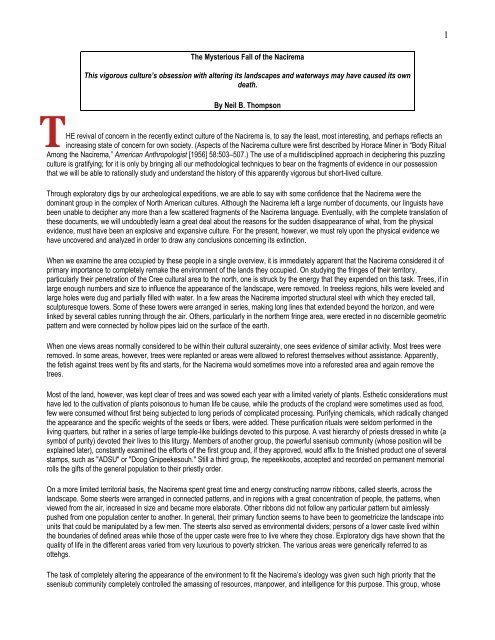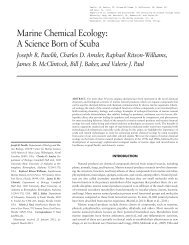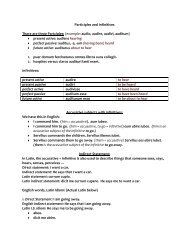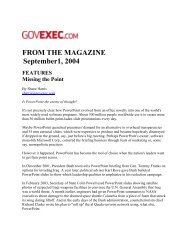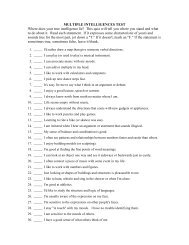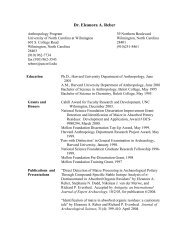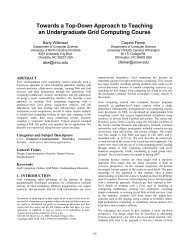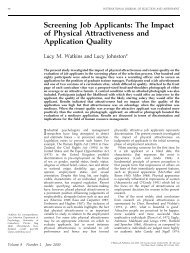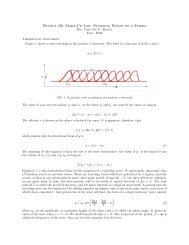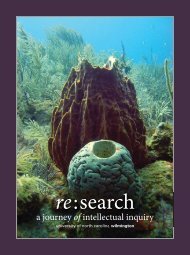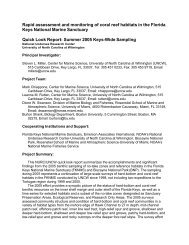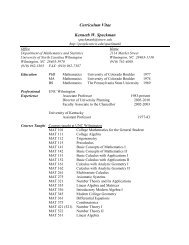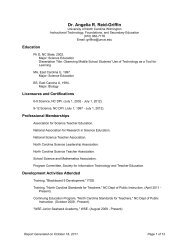The Mysterious Fall of the Nacirema - People Server at UNCW
The Mysterious Fall of the Nacirema - People Server at UNCW
The Mysterious Fall of the Nacirema - People Server at UNCW
You also want an ePaper? Increase the reach of your titles
YUMPU automatically turns print PDFs into web optimized ePapers that Google loves.
<strong>The</strong> <strong>Mysterious</strong> <strong>Fall</strong> <strong>of</strong> <strong>the</strong> <strong>Nacirema</strong><br />
This vigorous culture’s obsession with altering its landscapes and w<strong>at</strong>erways may have caused its own<br />
de<strong>at</strong>h.<br />
By Neil B. Thompson<br />
HE revival <strong>of</strong> concern in <strong>the</strong> recently extinct culture <strong>of</strong> <strong>the</strong> <strong>Nacirema</strong> is, to say <strong>the</strong> least, most interesting, and perhaps reflects an<br />
increasing st<strong>at</strong>e <strong>of</strong> concern for own society. (Aspects <strong>of</strong> <strong>the</strong> <strong>Nacirema</strong> culture were first described by Horace Miner in ―Body Ritual<br />
Among <strong>the</strong> <strong>Nacirema</strong>,‖ American Anthropologist [1956] 58:503–507.) <strong>The</strong> use <strong>of</strong> a multidisciplined approach in deciphering this puzzling<br />
culture is gr<strong>at</strong>ifying; for it is only by bringing all our methodological techniques to bear on <strong>the</strong> fragments <strong>of</strong> evidence in our possession<br />
th<strong>at</strong> we will be able to r<strong>at</strong>ionally study and understand <strong>the</strong> history <strong>of</strong> this apparently vigorous but short-lived culture.<br />
Through explor<strong>at</strong>ory digs by our archeological expeditions, we are able to say with some confidence th<strong>at</strong> <strong>the</strong> <strong>Nacirema</strong> were <strong>the</strong><br />
dominant group in <strong>the</strong> complex <strong>of</strong> North American cultures. Although <strong>the</strong> <strong>Nacirema</strong> left a large number <strong>of</strong> documents, our linguists have<br />
been unable to decipher any more than a few sc<strong>at</strong>tered fragments <strong>of</strong> <strong>the</strong> <strong>Nacirema</strong> language. Eventually, with <strong>the</strong> complete transl<strong>at</strong>ion <strong>of</strong><br />
<strong>the</strong>se documents, we will undoubtedly learn a gre<strong>at</strong> deal about <strong>the</strong> reasons for <strong>the</strong> sudden disappearance <strong>of</strong> wh<strong>at</strong>, from <strong>the</strong> physical<br />
evidence, must have been an explosive and expansive culture. For <strong>the</strong> present, however, we must rely upon <strong>the</strong> physical evidence we<br />
have uncovered and analyzed in order to draw any conclusions concerning its extinction.<br />
When we examine <strong>the</strong> area occupied by <strong>the</strong>se people in a single overview, it is immedi<strong>at</strong>ely apparent th<strong>at</strong> <strong>the</strong> <strong>Nacirema</strong> considered it <strong>of</strong><br />
primary importance to completely remake <strong>the</strong> environment <strong>of</strong> <strong>the</strong> lands <strong>the</strong>y occupied. On studying <strong>the</strong> fringes <strong>of</strong> <strong>the</strong>ir territory,<br />
particularly <strong>the</strong>ir penetr<strong>at</strong>ion <strong>of</strong> <strong>the</strong> Cree cultural area to <strong>the</strong> north, one is struck by <strong>the</strong> energy th<strong>at</strong> <strong>the</strong>y expended on this task. Trees, if in<br />
large enough numbers and size to influence <strong>the</strong> appearance <strong>of</strong> <strong>the</strong> landscape, were removed. In treeless regions, hills were leveled and<br />
large holes were dug and partially filled with w<strong>at</strong>er. In a few areas <strong>the</strong> <strong>Nacirema</strong> imported structural steel with which <strong>the</strong>y erected tall,<br />
sculpturesque towers. Some <strong>of</strong> <strong>the</strong>se towers were arranged in series, making long lines th<strong>at</strong> extended beyond <strong>the</strong> horizon, and were<br />
linked by several cables running through <strong>the</strong> air. O<strong>the</strong>rs, particularly in <strong>the</strong> nor<strong>the</strong>rn fringe area, were erected in no discernible geometric<br />
p<strong>at</strong>tern and were connected by hollow pipes laid on <strong>the</strong> surface <strong>of</strong> <strong>the</strong> earth.<br />
When one views areas normally considered to be within <strong>the</strong>ir cultural suzerainty, one sees evidence <strong>of</strong> similar activity. Most trees were<br />
removed. In some areas, however, trees were replanted or areas were allowed to reforest <strong>the</strong>mselves without assistance. Apparently,<br />
<strong>the</strong> fetish against trees went by fits and starts, for <strong>the</strong> <strong>Nacirema</strong> would sometimes move into a reforested area and again remove <strong>the</strong><br />
trees.<br />
Most <strong>of</strong> <strong>the</strong> land, however, was kept clear <strong>of</strong> trees and was sowed each year with a limited variety <strong>of</strong> plants. Es<strong>the</strong>tic consider<strong>at</strong>ions must<br />
have led to <strong>the</strong> cultiv<strong>at</strong>ion <strong>of</strong> plants poisonous to human life be cause, while <strong>the</strong> products <strong>of</strong> <strong>the</strong> cropland were sometimes used as food,<br />
few were consumed without first being subjected to long periods <strong>of</strong> complic<strong>at</strong>ed processing. Purifying chemicals, which radically changed<br />
<strong>the</strong> appearance and <strong>the</strong> specific weights <strong>of</strong> <strong>the</strong> seeds or fibers, were added. <strong>The</strong>se purific<strong>at</strong>ion rituals were seldom performed in <strong>the</strong><br />
living quarters, but ra<strong>the</strong>r in a series <strong>of</strong> large temple-like buildings devoted to this purpose. A vast hierarchy <strong>of</strong> priests dressed in white (a<br />
symbol <strong>of</strong> purity) devoted <strong>the</strong>ir lives to this liturgy. Members <strong>of</strong> ano<strong>the</strong>r group, <strong>the</strong> powerful ssenisub community (whose position will be<br />
explained l<strong>at</strong>er), constantly examined <strong>the</strong> efforts <strong>of</strong> <strong>the</strong> first group and, if <strong>the</strong>y approved, would affix to <strong>the</strong> finished product one <strong>of</strong> several<br />
stamps, such as "ADSU" or "Doog Gnipeekesouh." Still a third group, <strong>the</strong> repeekkoobs, accepted and recorded on permanent memorial<br />
rolls <strong>the</strong> gifts <strong>of</strong> <strong>the</strong> general popul<strong>at</strong>ion to <strong>the</strong>ir priestly order.<br />
On a more limited territorial basis, <strong>the</strong> <strong>Nacirema</strong> spent gre<strong>at</strong> time and energy constructing narrow ribbons, called steerts, across <strong>the</strong><br />
landscape. Some steerts were arranged in connected p<strong>at</strong>terns, and in regions with a gre<strong>at</strong> concentr<strong>at</strong>ion <strong>of</strong> people, <strong>the</strong> p<strong>at</strong>terns, when<br />
viewed from <strong>the</strong> air, increased in size and became more elabor<strong>at</strong>e. O<strong>the</strong>r ribbons did not follow any particular p<strong>at</strong>tern but aimlessly<br />
pushed from one popul<strong>at</strong>ion center to ano<strong>the</strong>r. In general, <strong>the</strong>ir primary function seems to have been to geometricize <strong>the</strong> landscape into<br />
units th<strong>at</strong> could be manipul<strong>at</strong>ed by a few men. <strong>The</strong> steerts also served as environmental dividers; persons <strong>of</strong> a lower caste lived within<br />
<strong>the</strong> boundaries <strong>of</strong> defined areas while those <strong>of</strong> <strong>the</strong> upper caste were free to live where <strong>the</strong>y chose. Explor<strong>at</strong>ory digs have shown th<strong>at</strong> <strong>the</strong><br />
quality <strong>of</strong> life in <strong>the</strong> different areas varied from very luxurious to poverty stricken. <strong>The</strong> various areas were generically referred to as<br />
ottehgs.<br />
<strong>The</strong> task <strong>of</strong> completely altering <strong>the</strong> appearance <strong>of</strong> <strong>the</strong> environment to fit <strong>the</strong> <strong>Nacirema</strong>’s ideology was given such high priority th<strong>at</strong> <strong>the</strong><br />
ssenisub community completely controlled <strong>the</strong> amassing <strong>of</strong> resources, manpower, and intelligence for this purpose. This group, whose<br />
1
ank bordered on th<strong>at</strong> <strong>of</strong> a nonregimented priestly caste, lived in areas th<strong>at</strong> were <strong>of</strong>ten guarded by electronic systems. <strong>The</strong>re is no<br />
evidence to suggest th<strong>at</strong> any restraints—moral, sociological, or<br />
engineering—were placed on <strong>the</strong>ir self-determined enterprises.<br />
For a period <strong>of</strong> about 300 solar cycles (a determin<strong>at</strong>ion made on <strong>the</strong><br />
basis <strong>of</strong> carbon-d<strong>at</strong>ing studies) <strong>the</strong> <strong>Nacirema</strong> devoted a major part <strong>of</strong><br />
<strong>the</strong>ir effort to <strong>the</strong> special environmental problem <strong>of</strong> changing <strong>the</strong><br />
appearance <strong>of</strong> air and w<strong>at</strong>er. Until <strong>the</strong> last 50 solar cycles <strong>of</strong> <strong>the</strong><br />
culture’s existence, <strong>the</strong>y seemed to have had only indifferent success.<br />
But during <strong>the</strong> short period before <strong>the</strong> fall <strong>of</strong> <strong>the</strong> culture, <strong>the</strong>y mastered <strong>the</strong>ir art magnificently. <strong>The</strong>y changed <strong>the</strong> color <strong>of</strong> <strong>the</strong> w<strong>at</strong>ers from<br />
<strong>the</strong> cool end <strong>of</strong> <strong>the</strong> spectrum (blues and greens) toward <strong>the</strong> warm end (reds and browns).<br />
<strong>The</strong> air was subjected to a similar alter<strong>at</strong>ion: it was changed from an azure shade to a uniform gray-yellow. This alter<strong>at</strong>ion <strong>of</strong> w<strong>at</strong>er and<br />
air was effected by building enormous plants in str<strong>at</strong>egic loc<strong>at</strong>ions. <strong>The</strong>se are usually found by our archeologists in or near large<br />
popul<strong>at</strong>ion centers, although, as success rewarded <strong>the</strong> <strong>Nacirema</strong>’s efforts, <strong>the</strong>y seem to have built smaller plants in outlying areas where<br />
environmental changes had not yet been effected <strong>The</strong>se plants constantly produced a variety <strong>of</strong> reagents, each appropri<strong>at</strong>e to its locale,<br />
which were <strong>the</strong>n pumped into <strong>the</strong> rivers and lakes or released into <strong>the</strong> <strong>at</strong>mosphere in <strong>the</strong> form <strong>of</strong> hot gases. <strong>The</strong> problem <strong>of</strong> disposing <strong>of</strong><br />
<strong>the</strong> many by-products <strong>of</strong> this process was solved by distributing <strong>the</strong>m among <strong>the</strong> general popul<strong>at</strong>ion which retained <strong>the</strong>m as vener<strong>at</strong>ed or<br />
decor<strong>at</strong>ive objects in <strong>the</strong>ir living quarters for a short time, <strong>the</strong>n discarded <strong>the</strong>m in <strong>the</strong> huge middens th<strong>at</strong> were established near every<br />
popul<strong>at</strong>ion center.<br />
In regions where colder temper<strong>at</strong>ures apparently prevented <strong>the</strong> reagents from changing <strong>the</strong> color <strong>of</strong> <strong>the</strong> w<strong>at</strong>er sufficiently, <strong>the</strong> <strong>Nacirema</strong>,<br />
near <strong>the</strong> end <strong>of</strong> <strong>the</strong>ir cultural explosion, built special plants th<strong>at</strong> economically raised <strong>the</strong> w<strong>at</strong>er temper<strong>at</strong>ure to an acceptable level for <strong>the</strong><br />
desired chemical reaction.<br />
<strong>The</strong> idea <strong>of</strong> a man-made environment was so pervasive th<strong>at</strong> in some areas, notably in <strong>the</strong> provinces called Ainr<strong>of</strong>ilac and Anaisiuol, <strong>the</strong><br />
<strong>Nacirema</strong> even tried to alter <strong>the</strong> appearance <strong>of</strong> <strong>the</strong> ocean currents. In <strong>the</strong>se regions <strong>the</strong>y erected steel sculptures in <strong>the</strong> sea itself and<br />
through <strong>the</strong>m released a black and slick substance, which stained <strong>the</strong> w<strong>at</strong>ers and <strong>the</strong> beaches. This experiment how ever, was rel<strong>at</strong>ively<br />
unsuccessful since <strong>the</strong> stains were not permanent and <strong>the</strong> <strong>Nacirema</strong> apparently never mastered a technique for constantly supplying <strong>the</strong><br />
reagent.<br />
<strong>The</strong> quasi-religious Elibomotua Cult, which sought to cre<strong>at</strong>e<br />
an intense sense <strong>of</strong> individual involvement in <strong>the</strong> community<br />
effort to completely control <strong>the</strong> environment.<br />
devoted to <strong>the</strong> cre<strong>at</strong>ion <strong>of</strong> an artistic symbol for a man-made environmental system.<br />
For a period <strong>of</strong> about 300 solar cycles (a determin<strong>at</strong>ion made<br />
on <strong>the</strong> basis <strong>of</strong> carbon-d<strong>at</strong>ing studies) <strong>the</strong> <strong>Nacirema</strong> devoted<br />
a major part <strong>of</strong> <strong>the</strong>ir effort to <strong>the</strong> special environ-<br />
mental problem <strong>of</strong> changing <strong>the</strong> appearance <strong>of</strong> air and w<strong>at</strong>er.<br />
Early research has disclosed <strong>the</strong> importance <strong>of</strong> ritualistic observance<br />
among <strong>the</strong> <strong>Nacirema</strong>. In support <strong>of</strong> <strong>the</strong>se observ<strong>at</strong>ions, we should note<br />
<strong>the</strong> presence <strong>of</strong> <strong>the</strong> quasi-religious Elibomotua Cult, which sought to<br />
cre<strong>at</strong>e an intense sense <strong>of</strong> individual involvement in <strong>the</strong> community<br />
effort to completely control <strong>the</strong> environment. This pervasive cult was<br />
<strong>The</strong> high esteem <strong>of</strong> <strong>the</strong> cult is demonstr<strong>at</strong>ed by <strong>the</strong> fact th<strong>at</strong> near every popul<strong>at</strong>ion center, when not disturbed by <strong>the</strong> accumul<strong>at</strong>ion <strong>of</strong><br />
debris, archeologists have found large and orderly collections <strong>of</strong> <strong>the</strong> Elibomotua Cult symbol. <strong>The</strong> vast number <strong>of</strong> <strong>the</strong>se collections has<br />
given us <strong>the</strong> opportunity to reconstruct with considerable confidence <strong>the</strong> principal ideas <strong>of</strong> <strong>the</strong> cult. <strong>The</strong> newest symbols seem to have<br />
nearly approached <strong>the</strong> ultim<strong>at</strong>e <strong>of</strong> <strong>the</strong> <strong>Nacirema</strong>’s cultural ideal. <strong>The</strong>ir colors, m<strong>at</strong>erial, and size suggest an enclosed mobile device th<strong>at</strong><br />
corresponds to no color or shape found in n<strong>at</strong>ure, although some authorities suggest th<strong>at</strong>, <strong>at</strong> some early time in <strong>the</strong> development, <strong>the</strong><br />
egg may have been <strong>the</strong> model. <strong>The</strong> device was provided with its own clim<strong>at</strong>e control system as well as a system th<strong>at</strong> screened out many<br />
<strong>of</strong> <strong>the</strong> shorter rays <strong>of</strong> <strong>the</strong> light spectrum.<br />
<strong>The</strong> object was designed to elimin<strong>at</strong>e most sounds from <strong>the</strong> outside and to fill <strong>the</strong> interior with a hypnotic humming sound when <strong>the</strong><br />
machine was in oper<strong>at</strong>ion. This noise could be altered in pitch and intensity by <strong>the</strong> manipul<strong>at</strong>ion, through simple mechanical controls, <strong>of</strong><br />
an ingenious mechanism loc<strong>at</strong>ed outside <strong>the</strong> oper<strong>at</strong>or’s compartment. This mechanism also produced a gaseous substance th<strong>at</strong>, in a<br />
small area, could change <strong>the</strong> appearance <strong>of</strong> <strong>the</strong> air in a manner similar to <strong>the</strong> permanent plant install<strong>at</strong>ions.<br />
2
In <strong>the</strong> early stages <strong>of</strong> <strong>the</strong> symbol’s development, this was probably only a<br />
ritualistic performance since <strong>the</strong> production plant was small and was fueled<br />
by a small tank. This function, however, may have been <strong>the</strong> primary reason<br />
for <strong>the</strong> cult’s symbol: to provide each family with its own device for altering<br />
<strong>the</strong> environment by giving it a priv<strong>at</strong>e microuniverse with a system <strong>of</strong><br />
producing <strong>the</strong> much desired air-changing reagent.<br />
<strong>The</strong> complete machined piece was somewh<strong>at</strong> fragile. Our tests <strong>of</strong> <strong>the</strong> suspension system indic<strong>at</strong>e th<strong>at</strong> it was virtually immobile on<br />
unimproved terrain; by all <strong>of</strong> our physical evidence, its movement was restricted to <strong>the</strong> surfaced steerts th<strong>at</strong> <strong>the</strong> <strong>Nacirema</strong> had built to<br />
geometricize <strong>the</strong> landscape.<br />
We are rel<strong>at</strong>ively certain th<strong>at</strong> a specially endowed and highly skilled group <strong>of</strong> educ<strong>at</strong>ors was employed to keep <strong>the</strong> importance <strong>of</strong> <strong>the</strong>se<br />
enclosed mobile devices constantly in <strong>the</strong> public eye. Working in an as yet unloc<strong>at</strong>ed area th<strong>at</strong> <strong>the</strong>y referred to as Euneva Nosidam,<br />
<strong>the</strong>se specialists printed periodical m<strong>at</strong>ter and transmitted electronic-impulse images to boxlike appar<strong>at</strong>us in all homes.<br />
While some <strong>of</strong> <strong>the</strong> inform<strong>at</strong>ion was aimed <strong>at</strong> describing <strong>the</strong> appearance and performance characteristics <strong>of</strong> <strong>the</strong> various kinds <strong>of</strong><br />
machines, <strong>the</strong> gre<strong>at</strong>est portion <strong>of</strong> <strong>the</strong> m<strong>at</strong>erial was seemingly aimed <strong>at</strong> something o<strong>the</strong>r than <strong>the</strong>se factors. A distinguished group <strong>of</strong><br />
linguists, social psychologists, and <strong>the</strong>ologians, who presented <strong>the</strong> principal symposium <strong>at</strong> our most recent anthropological conference,<br />
<strong>of</strong>fered <strong>the</strong> hypo<strong>the</strong>sis th<strong>at</strong> <strong>the</strong> elibomotua symbols, also known as racs, replaced <strong>the</strong> processes <strong>of</strong> n<strong>at</strong>ural selection in <strong>the</strong> courtship and<br />
m<strong>at</strong>ing rituals <strong>of</strong> <strong>the</strong> <strong>Nacirema</strong>. Through unconscious suggestion, which derived from Euneva Nosidam’s ―mcnahulesque‖ m<strong>at</strong>erials, <strong>the</strong><br />
female was uncontrollably driven to select her m<strong>at</strong>e by <strong>the</strong> kind <strong>of</strong> elibomotua he occupied. <strong>The</strong> males <strong>of</strong> <strong>the</strong> culture were persuaded to<br />
believe th<strong>at</strong> any handicap to masculine dominance could be overcome by selecting <strong>the</strong> proper cult symbol. In this way, <strong>the</strong> future <strong>of</strong> <strong>the</strong><br />
race, as represented by <strong>Nacirema</strong> culture, was determined by unn<strong>at</strong>ural man-made techniques.<br />
<strong>The</strong> symposium was careful to point out th<strong>at</strong> we have not yet un covered any hard evidence to show whe<strong>the</strong>r or not this cultural trait<br />
actually had any effect on <strong>the</strong> race or its popul<strong>at</strong>ion growth. We have found, however, one strange sculpture from <strong>the</strong> Pop Loohcs<br />
depicting a male and female m<strong>at</strong>ing in an elibomotua’s rear compartment, indic<strong>at</strong>ing a direct rel<strong>at</strong>ionship. <strong>The</strong> hypo<strong>the</strong>sis has <strong>the</strong> virtue<br />
<strong>of</strong> corresponding to <strong>the</strong> standard anthropological interpret<strong>at</strong>ions <strong>of</strong> <strong>the</strong> <strong>Nacirema</strong> culture—th<strong>at</strong> it was ritual ridden and devoted to <strong>the</strong> goal<br />
<strong>of</strong> man’s control <strong>of</strong> <strong>the</strong> environment.<br />
Fur<strong>the</strong>r evidence <strong>of</strong> <strong>the</strong> <strong>Nacirema</strong>’s devotion to <strong>the</strong> Elibomotua Cult has been discovered in surviving scraps <strong>of</strong> gnivom serutcip. Some <strong>of</strong><br />
<strong>the</strong>se suggest th<strong>at</strong> one <strong>of</strong> <strong>the</strong> most important quasi-religious ceremonies was performed by large groups who ga<strong>the</strong>red <strong>at</strong> open-air<br />
shrines built in imit<strong>at</strong>ion <strong>of</strong> a planetary ellipse and called a kcartecar. <strong>The</strong>re, with intensely emotional reactions, <strong>the</strong>se crowds w<strong>at</strong>ched a<br />
ritual in which powerful gnicar racs performed <strong>the</strong>ir idealized concept <strong>of</strong> <strong>the</strong> correct behavior <strong>of</strong> <strong>the</strong> planets in <strong>the</strong> universe. Apparently,<br />
<strong>the</strong>ir deep-se<strong>at</strong>ed need for a controlled environment was thus emotionally achieved.<br />
<strong>The</strong> racs did not hold a steady position in <strong>the</strong> planetarium, but changed <strong>the</strong>ir rel<strong>at</strong>ionship to <strong>the</strong> o<strong>the</strong>r racs ra<strong>the</strong>r frequently. Occasionally<br />
a special ritual, designed to emphasize man’s power over his universe, was enacted. On <strong>the</strong>se unannounced occasions one or more <strong>of</strong><br />
<strong>the</strong> planet symbols was destroyed by crashing two <strong>of</strong> <strong>the</strong>m toge<strong>the</strong>r or by throwing one against a wall.<br />
<strong>The</strong> males <strong>of</strong> <strong>the</strong> culture were persuaded to believe th<strong>at</strong> any<br />
handicap to masculine dominance could be overcome by<br />
selecting <strong>the</strong> proper cult symbol. In this way, <strong>the</strong> future <strong>of</strong> <strong>the</strong><br />
race, as represented by <strong>Nacirema</strong> culture, was determined<br />
by unn<strong>at</strong>ural man-made techniques.<br />
A distinguished group <strong>of</strong> linguists, social psychologists,<br />
and <strong>the</strong>ologians, who presented <strong>the</strong> principal symposium<br />
<strong>at</strong> our most recent anthropological conference, <strong>of</strong>fered<br />
<strong>the</strong> hypo<strong>the</strong>sis th<strong>at</strong> <strong>the</strong> Elibomotua symbols, also known<br />
as racs, replaced <strong>the</strong> processes <strong>of</strong> n<strong>at</strong>ural selection in<br />
<strong>the</strong> courtship and m<strong>at</strong>ing rituals <strong>of</strong> <strong>the</strong> <strong>Nacirema</strong>.<br />
<strong>The</strong> emotional pitch <strong>of</strong> <strong>the</strong> worshipers rose to its highest level <strong>at</strong> this<br />
moment. <strong>The</strong>n, on command <strong>of</strong> <strong>the</strong> high priest <strong>of</strong> <strong>the</strong> ceremony, all <strong>the</strong><br />
gnicar racs were slowed to a funereal speed and carefully held in <strong>the</strong>ir<br />
rel<strong>at</strong>ive positions. After an appropri<strong>at</strong>e memorial period honoring man’s<br />
symbolic control <strong>of</strong> <strong>the</strong> universe, <strong>the</strong> machines were given <strong>the</strong> signal to<br />
resume <strong>the</strong>ir err<strong>at</strong>ic speeds and permitted to make unn<strong>at</strong>ural position<br />
changes.<br />
We can only specul<strong>at</strong>e on <strong>the</strong> significance <strong>of</strong> this ritual, but it seems reasonable to conclude th<strong>at</strong> it served as an educ<strong>at</strong>ional device,<br />
constantly imprinting in <strong>the</strong> individual <strong>the</strong> society’s most important values.<br />
Many <strong>of</strong> <strong>the</strong> findings <strong>of</strong> archeological explor<strong>at</strong>ions suggest th<strong>at</strong> <strong>the</strong>se symbols <strong>of</strong> universal power took up a large portion <strong>of</strong> <strong>the</strong> time and<br />
energy <strong>of</strong> <strong>the</strong> <strong>Nacirema</strong> society. Evidence indic<strong>at</strong>es th<strong>at</strong> a sizable portion <strong>of</strong> <strong>the</strong> work force and enormous amounts <strong>of</strong> space must have<br />
been devoted to <strong>the</strong> manufacture, distribution, and ceremonial care <strong>of</strong> <strong>the</strong> devices. Some <strong>of</strong> <strong>the</strong> biggest production units <strong>of</strong> <strong>the</strong> economy<br />
were assigned this function; extensive design labor<strong>at</strong>ories were given over to <strong>the</strong> manipul<strong>at</strong>ion <strong>of</strong> styles and appearances, and assembly<br />
3
lines turned out <strong>the</strong> pieces in serial fashion <strong>The</strong>y were given a variety <strong>of</strong> names, although all <strong>of</strong> those made in <strong>the</strong> same time period<br />
looked remarkably alike.<br />
Every family assumed <strong>the</strong> responsibility for one <strong>of</strong> <strong>the</strong> machined pieces and vener<strong>at</strong>ed it for a period <strong>of</strong> two to four solar cycles. Some<br />
families who lived in areas where a high quality <strong>of</strong> life was maintained took from two to four pieces into <strong>the</strong>ir care. During <strong>the</strong> time a<br />
family held a piece, <strong>the</strong>y ritually cleansed it, housed it from <strong>the</strong> elements, and took it to special shrines where priests gave it a variety <strong>of</strong><br />
injections.<br />
<strong>The</strong> <strong>Nacirema</strong> spent much <strong>of</strong> <strong>the</strong>ir time inside <strong>the</strong>ir elibomotuas moving about on <strong>the</strong> steerts. Pictures show th<strong>at</strong> almost everyone<br />
engaged, once in <strong>the</strong> morning and once in <strong>the</strong> evening, in wh<strong>at</strong> must have been an important mass ritual, which we have been unable to<br />
decipher with any surety. During <strong>the</strong>se periods <strong>of</strong> <strong>the</strong> day, people <strong>of</strong> both sexes and all ages, except <strong>the</strong> very young and <strong>the</strong> very old, left<br />
<strong>the</strong>ir quarters to move about on <strong>the</strong> steerts in <strong>the</strong>ir racs. Films <strong>of</strong> <strong>the</strong>se periods <strong>of</strong> <strong>the</strong> day show scenes analogous to <strong>the</strong> dance one can<br />
occasionally see in a swarm <strong>of</strong> honeybees. In large popul<strong>at</strong>ion centers this ―dance <strong>of</strong> <strong>the</strong> racs" lasted for two or three hours. Some<br />
students have suggested th<strong>at</strong> since <strong>the</strong> swarm dances took place <strong>at</strong> about <strong>the</strong> time <strong>the</strong> earth completed one-half an axial rot<strong>at</strong>ion, it may<br />
have been a liturgical denial <strong>of</strong> <strong>the</strong> n<strong>at</strong>ural processes <strong>of</strong> <strong>the</strong> universe.<br />
Inasmuch as we are reasonably certain th<strong>at</strong> after <strong>the</strong> rite most <strong>of</strong> <strong>the</strong> adults and all <strong>of</strong> <strong>the</strong> children left <strong>the</strong> racs and were confined inside<br />
man-made structures variously called loohcs, eciffos, tnalps, or emohs and, when released, went immedi<strong>at</strong>ely to <strong>the</strong>ir racs and engaged<br />
in <strong>the</strong> next swarming, <strong>the</strong> suggestion may be apropos. <strong>The</strong> ardent involvement <strong>of</strong> <strong>the</strong> whole popul<strong>at</strong>ion from ages 6 through 65 indic<strong>at</strong>es<br />
th<strong>at</strong> it was one <strong>of</strong> <strong>the</strong> strongest mores <strong>of</strong> <strong>the</strong> culture, perhaps approaching an instinctual behavior p<strong>at</strong>tern.<br />
It should also be mentioned th<strong>at</strong>, when inside <strong>the</strong>ir racs, people were not restricted to <strong>the</strong>ir ottehgs, but were free to go any where <strong>the</strong>y<br />
chose so long as <strong>the</strong>y remained on <strong>the</strong> steerts. Apparently, when <strong>the</strong>y were confined inside a rac, <strong>the</strong> <strong>Nacirema</strong> <strong>at</strong>tained a st<strong>at</strong>e <strong>of</strong><br />
equality, which elimin<strong>at</strong>ed <strong>the</strong> danger <strong>of</strong> any caste contamin<strong>at</strong>ion. <strong>The</strong>se, <strong>the</strong>n, to <strong>the</strong> best <strong>of</strong> our present st<strong>at</strong>e <strong>of</strong> knowledge, were <strong>the</strong><br />
principal familial uses <strong>of</strong> <strong>the</strong> Elibomotua Cult symbols. After a family had cared for a piece long enough to burnish it with a certain p<strong>at</strong>ina,<br />
it was routinely replaced by ano<strong>the</strong>r, and <strong>the</strong> used rac was assigned to a gallery keeper, who placed it on permanent display in an<br />
outdoor gallery, sometimes surrounded by trees or a fence, but usually not concealed in any way. During <strong>the</strong>ir free time, many persons,<br />
especially those from <strong>the</strong> ottehgs <strong>of</strong> <strong>the</strong> lesser sorts, came to study <strong>the</strong> various symbols on display and sometimes carried away small<br />
parts to be used for an unknown purpose.<br />
<strong>The</strong>re seems to be little doubt th<strong>at</strong> <strong>the</strong> Cult <strong>of</strong> <strong>the</strong> Elibomotua was so fervently embraced by <strong>the</strong> general popul<strong>at</strong>ion, and th<strong>at</strong> <strong>the</strong> daily<br />
rituals <strong>of</strong> <strong>the</strong> rac’s care and use were so faithfully performed, th<strong>at</strong> <strong>the</strong> minute quantities <strong>of</strong> reagent thus distributed may have had a<br />
decisive effect on <strong>the</strong> chemical characteristics <strong>of</strong> <strong>the</strong> air. <strong>The</strong> elibomotua, <strong>the</strong>refore, may have contributed in a major way toward <strong>the</strong><br />
prized objective <strong>of</strong> a totally man-made environment.<br />
In summary, our evalu<strong>at</strong>ion <strong>of</strong> both <strong>the</strong> <strong>Nacirema</strong>’s man-made environmental alter<strong>at</strong>ions and <strong>the</strong> artifacts found in <strong>the</strong>ir territories lead us<br />
to advance <strong>the</strong> hypo<strong>the</strong>sis th<strong>at</strong> <strong>the</strong>y may have been responsible for <strong>the</strong>ir own extinction. <strong>The</strong> <strong>Nacirema</strong> culture may have been so<br />
successful in achieving its objectives th<strong>at</strong> <strong>the</strong> inherited physiological mechanisms <strong>of</strong> its people were unable to cope with its manufactured<br />
environment.<br />
http://www.n<strong>at</strong>uralhistorymag.com/master.html?http://www.n<strong>at</strong>uralhistorymag.com/editors_pick/1972_12_pick.html<br />
4


